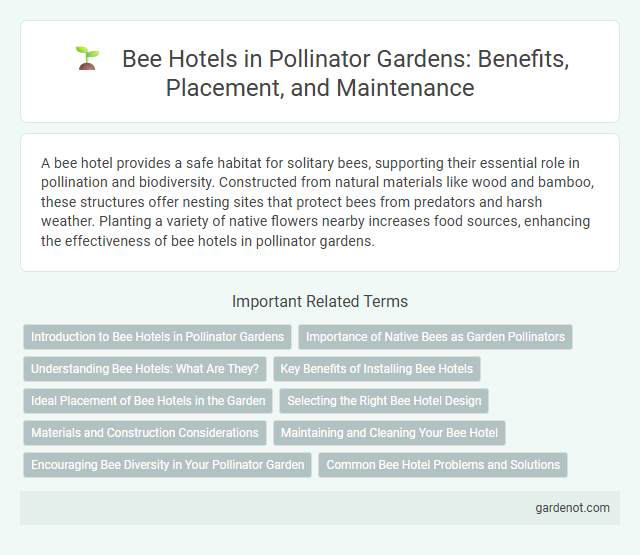A bee hotel provides a safe habitat for solitary bees, supporting their essential role in pollination and biodiversity. Constructed from natural materials like wood and bamboo, these structures offer nesting sites that protect bees from predators and harsh weather. Planting a variety of native flowers nearby increases food sources, enhancing the effectiveness of bee hotels in pollinator gardens.
Introduction to Bee Hotels in Pollinator Gardens
Bee hotels provide essential nesting habitats for solitary bees, crucial pollinators in garden ecosystems. These structures mimic natural environments such as hollow stems or wood cavities, supporting species like mason bees and leafcutter bees. Integrating bee hotels in pollinator gardens enhances biodiversity and boosts pollination, promoting healthier plant growth and increased crop yields.
Importance of Native Bees as Garden Pollinators
Native bees play a crucial role in pollination within pollinator gardens by enhancing plant reproduction and biodiversity. Unlike honeybees, native bees are often more efficient at pollinating specific local flora, which supports garden health and ecosystem stability. Installing bee hotels provides essential nesting habitats, boosting native bee populations and improving pollination rates in urban and suburban gardens.
Understanding Bee Hotels: What Are They?
Bee hotels provide essential nesting habitats for solitary bees by mimicking their natural environments with tubes, holes, and cavities made from wood, bamboo, or reeds. These structures support pollinator populations by offering safe breeding sites, contributing to increased biodiversity and enhanced plant pollination. Understanding bee hotels involves recognizing their role in conserving native bee species and promoting sustainable gardening practices.
Key Benefits of Installing Bee Hotels
Installing bee hotels supports local biodiversity by providing essential nesting habitats for solitary bees like mason and leafcutter bees. These structures enhance pollination rates in gardens and agricultural areas, boosting plant health and crop yields. Bee hotels also contribute to environmental education by raising awareness about the importance of native pollinators in ecosystem balance.
Ideal Placement of Bee Hotels in the Garden
Place bee hotels in a sunny, sheltered spot that is protected from strong winds and heavy rain to encourage occupancy by solitary bees. Position the hotel at least 3 to 5 feet above the ground, ideally facing southeast to maximize morning sunlight and warmth. Ensure nearby native flowering plants and a water source are available to create a supportive habitat that promotes pollinator activity and biodiversity.
Selecting the Right Bee Hotel Design
Choosing the right bee hotel design is essential for supporting native solitary bees, which prefer a variety of hole sizes and materials such as untreated wood or bamboo. Ensuring the structure has proper drainage and ventilation prevents mold and parasites, promoting healthy bee populations. Positioning the bee hotel in a sunny, sheltered spot near diverse flowering plants enhances pollination and biodiversity in your garden.
Materials and Construction Considerations
Bee hotels require natural, untreated materials like bamboo, hollow stems, and hardwood blocks to attract solitary bees effectively. Construction should include varying hole diameters from 2 to 10 millimeters to accommodate different bee species, with a depth of around 10 to 15 centimeters for optimal nesting. Ensuring drainage holes and a protective overhang helps prevent moisture buildup and prolongs the structure's lifespan.
Maintaining and Cleaning Your Bee Hotel
Regular maintenance of a bee hotel is essential to support healthy solitary bee populations and prevent parasite infestations. Clean nesting tubes annually by removing debris and replacing damaged or moldy materials to encourage successful bee reproduction. Position the bee hotel in a dry, sheltered area to minimize exposure to harsh weather and help maintain optimal nesting conditions.
Encouraging Bee Diversity in Your Pollinator Garden
Installing bee hotels in your pollinator garden provides essential nesting habitats for solitary bees, increasing local bee diversity and supporting pollination. These structures attract various native bee species by offering safe, pesticide-free environments that mimic natural nesting sites. Incorporating bee hotels enhances ecosystem health, fosters plant reproduction, and promotes biodiversity within your garden.
Common Bee Hotel Problems and Solutions
Common bee hotel problems include mold growth, predation by birds or other insects, and overcrowding in nesting tubes, which can reduce nesting success. Solutions involve proper maintenance such as cleaning or replacing nesting materials annually, using protective mesh to deter predators, and providing a variety of tube sizes to accommodate different bee species. Placing the bee hotel in a sunny, sheltered location with good airflow also helps prevent moisture buildup and promotes healthy bee populations.
Bee hotel Infographic

 gardenot.com
gardenot.com